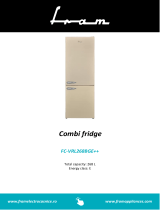
EN - 12
• Do not place explosive or ammable
material in your fridge. Place drinks with
high alcohol content vertically in the
fridge compartment and make sure their
tops are tightly closed.
• When removing ice from the ice-making
compartment, do not touch it. Ice may
cause frost burns and/or cuts.
• Do not touch frozen goods with wet
hands. Do not eat ice-cream or ice cubes
immediately after they are removed from
the ice-making compartment.
• Do not re-freeze thawed frozen food. This
may cause health issues such as food
poisoning.
Old and Out-of-order Fridges
• If your old fridge or freezer has a
lock, break or remove the lock before
discarding it, because children may
get trapped inside it and may cause an
accident.
• Old fridges and freezers contain
isolation material and refrigerant with
CFC. Therefore, take care not to harm
environment when you are discarding
your old fridges.
CE Declaration of conformity
By placing the mark on this product,
we are conrming compliance to all
relevant European safety, health and
environmental requirements which are
applicable in legislation for this product.
SCRAPPING OLD APPLIANCES
This appliance is marked according to
the European directive 2012/19/EU on
Waste Electrical and Electronic Equipment
(WEEE).
WEEE contains both polluting substances
(which can cause negative consequences
for the environment) and basic components
(which can be re-used). It is important
to have WEEE subjected to specic
treatments, in order to remove and dispose
properly all pollutants, and recover and
recycle all materials.
Individuals can play an important role in
ensuring that WEEE does not become an
environmental issue; it is essential to follow
some basic rules:
- WEEE should not be treated as
household waste;
- WEEE should be handed over to the
relevant collection points managed
by the municipality or by registered
companies. In many countries, for
large WEEE, home collection could be
present.
In many countries, when you buy a new
appliance, the old one may be returned
to the retailer who has to collect it free of
charge on a one-to-one basis, as long as
the equipment is of equivalent type and
has the same functions as the supplied
equipment.
Packaging and the Environment
Packaging materials protect
your machine from damage that
may occur during transportation.
The packaging materials are
environmentally friendly as they are
recyclable. The use of recycled material
reduces raw material consumption and
therefore decreases waste production.
Notes:
• Please read the instruction manual
carefully before installing and using your
appliance. We are not responsible for the
damage occurred due to misuse.
• Follow all instructions on your appliance
and instruction manual, and keep this
manual in a safe place to resolve the
problems that may occur in the future.
• This appliance is produced to be used
in homes and it can only be used in
domestic environments and for the
specied purposes. It is not suitable for
commercial or common use. Such use
will cause the guarantee of the appliance
to be cancelled and our company will
not be responsible for the losses to be
occurred.




















